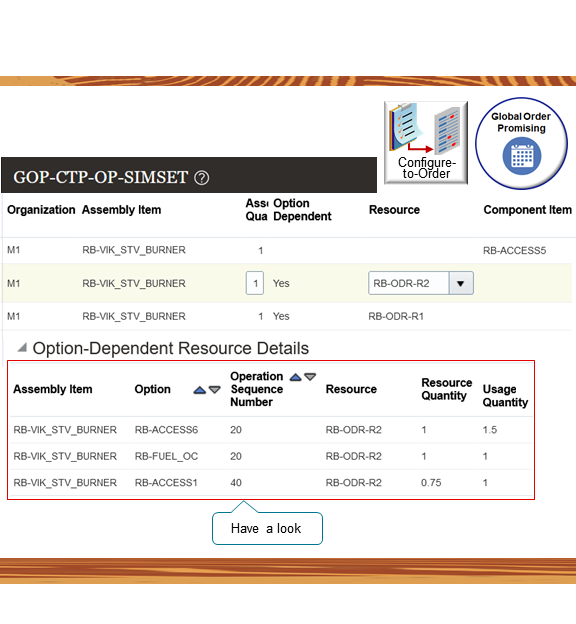Include Resources for Configure Options
You can check availability and schedule the resources that you need to fulfill a configure option and include them in your bill of resources. The bill of resources will also include more detail, such as the usage quantity, operation sequence number, and the resource's quantity.
Use this feature to determine the scheduled date for different configurations of an assemble-to-order configured item. Use it in your capable-to-promise flow.
Promising can determine what resources are available according to the configure options that your user selects. This improves the accuracy of your promising results.
Use this feature when:
- The options that your user selects affects the resources that are available.
- You use different resources to build different configurations, and the options that your user selects affects the resources that you use to make them.
Example 1: Include Resources When Your Options Are in a Class
Assume you set up a hierarchy in your configuration model.
| Hierarchy | Operation | Operation Is Option Dependent | Resource |
|---|---|---|---|
| Class A | 10 | Yes | R1 |
| Option 1 | - | - | - |
| Option 2 | - | - | - |
| Class B | 20 | No | R2 |
| Option 3 | - | - | - |
| Option 4 | - | - | - |
Assume your item has:
- Operation 10. The operation is option dependent, it consumes the R1 resource, and you apply it to option class A.
- Operation 20. The operation isn't option dependent, it consumes the R2 resource, and you apply it to option class B.
At run time, the user selects option 1 in class A, and option 3 in class B.
| Hierarchy | Operation | Operation Is Option Dependent | Resource |
|---|---|---|---|
| Class A | 10 | Yes | R1 |
| Option 1 | - | - | - |
| Option 2 | - | - | - |
| Class B | 20 | No | R2 |
| Option 3 | - | - | - |
| Option 4 | - | - | - |
Note
- If the user selects option 1 or option 2 in class A, then Promising will consume supply from R1.
- Promising will always consume supply from R2 because R2 isn't option dependent.
- Your bill of resources will include the R1 resource.
Example 2: Include Resources When Your Options Aren't in a Class
Assume you set up a configuration model where you have options but they're not in a class.
| Hierarchy | Operation | Operation Is Option Dependent | Resource |
|---|---|---|---|
| Option 1 | 10 | Y | R1 |
| Option 2 | 20 | Y | R2 |
| Option 3 | 30 | Y | R3 |
| Option 4 | 40 | Y | R4 |
At run time, the user selects option 1 and option 3.
| Hierarchy | Operation | Operation Is Option Dependent | Resource |
|---|---|---|---|
| Option 1 | 10 | Y | R1 |
| Option 2 | 20 | Y | R2 |
| Option 3 | 30 | Y | R3 |
| Option 4 | 40 | Y | R4 |
The bill of resources will contain details about the option dependent choices for each resource, R1, R2, R3, and R4.
Promising will consume supply only for the options that the user selects. So it will consume supply for R1 and R3.
Note
- If a resource is critical, and if you attach a resource to an operation that depends on an option, then the bill of resources will represent the resource as option dependent.
- Your bill of resources will automatically include resources that are option dependent.
- The bill of resources will mark resources that are critical as option dependent.
- The bill of resources doesn't consider effective dates.
- Promising only creates data for resources that are option dependent where the Option Class or the Option is immediately below the top level of the hierarchy in your configuration model.
- You can't modify option dependent data directly in the bill of resources.
To see how all this shows up in your bill of resources, go to the Aggregate Bill Of Resource tab, then examine these attributes.
- Resource
- Option Dependent
- Component Item
For details about the Aggregate Bill Of Resource tab, see Overview of Using Bills of Resources with Promising.
For details about what option dependent means, see Guidelines for Creating Work Definitions for Configured Items.
Want to Try It?
| Step | Description | Learn How |
|---|---|---|
| 1 | Identify the critical manufacturing components and resources. | Overview of Using Bills of Resources with Promising |
| 2 | Create an ATP rule, set the Promising Mode attribute on the rule to Supply Chain Availability Search, and enable the Search Components and Resources option on the rule. | Promising Modes for ATP Rules |
| 3 | Create a sourcing rule and set its Type attribute to Make At. | Source Your Supply Chain |
| 4 | Enable the Option Dependent option on the work order. | Guidelines for Creating Work Definitions for Configured Items |
| 5 | Collect the Items, Resources, Item Structure, and Work Definition entities. | Collect Data for Global Order Promising |
| 6 | Run the Create Bills of Resources scheduled process. Set the Bills of Resources Templates parameter to Capable to Promise when you run it. | Overview of Using Bills of Resources with Promising |
| 7 | Go to the Order Promising Options page, then select the simulation set that you want Promising to consider. For details, see Manage Order Promising Options. | - |
Examine the output in the simulation set. For example:
